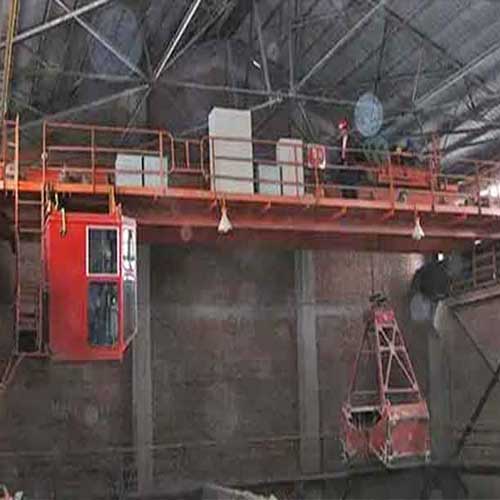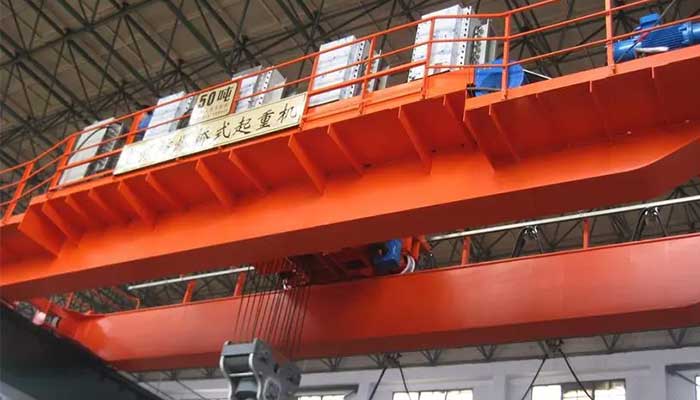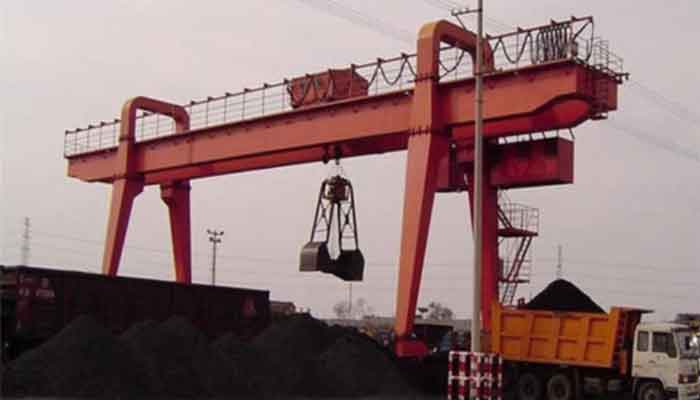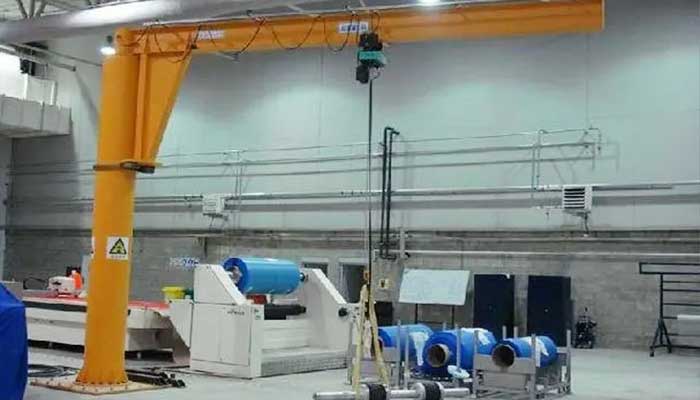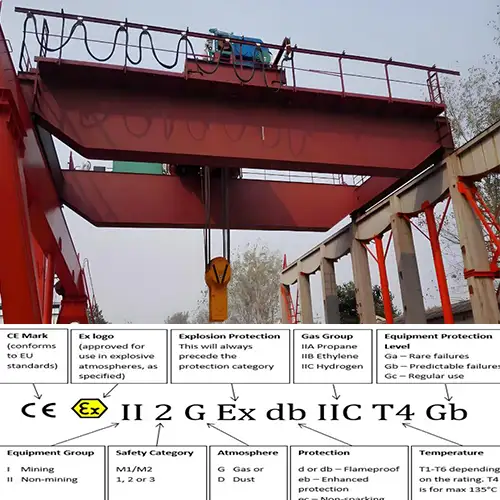When to Invest in Explosion-Proof Cranes: Signs You Can’t Ignore
Recognize crucial signs, i.e., safety risks & compliance, for timely investment in explosion-proof cranes for hazardous environments.Get exproof crane!
Category: Featured
Your Trusted Explosion Proof Overhead Crane Manufacturer & Supplier
When to Invest in an Explosion-Proof Crane
Signs You Can't Ignore
Introduction What is an Explosion-Proof Crane?
An explosion-proof crane is built to work safely in environments where there's a risk of explosions. These cranes are specially designed to prevent sparks or heat from escaping, which could ignite gases or dust that might be present in the air. They are essential in industries like:
- Chemical plants
- Oil refineries
- Mining operations
- Any other facility handling flammable or explosive materials
Why is it Important to Understand When to Invest?
Knowing when to invest in an explosion-proof crane is key to keeping your workplace safe. Using the wrong equipment in hazardous areas can lead to serious accidents, including fires or explosions. Regular cranes aren't built to handle these risks, which is why explosion-proof cranes are necessary.
- Protect your workers and equipment
- Avoid expensive accidents and downtime
- Stay compliant with safety regulations
Explosion-proof cranes ensure you meet safety standards while preventing dangerous situations.
Purpose of This Guide
This guide is designed to help you recognize when it's time to invest in an explosion-proof crane. You'll learn about the signs that indicate you need one, so you can make an informed decision about your equipment.
- Recognize the risks in your environment
- Understand safety regulations and compliance needs
- Know when it's time to upgrade your crane fleet
By the end of this guide, you'll have a clearer idea of when an explosion-proof crane is a must for your business.
Explosion-Proof Cranes
What is an Explosion-Proof Crane?
An explosion-proof crane is engineered to safely operate in environments with a high risk of explosions. These cranes are built with advanced features to prevent any sparks, heat, or electrical malfunctions that could ignite hazardous materials such as gases, vapors, or dust in the air. Unlike standard cranes, explosion-proof models adhere to strict safety standards, providing peace of mind in hazardous operations. Key features include:
- Sealed Electrical Components: These prevent sparks or heat from escaping, ensuring that electrical faults do not lead to ignition in explosive atmospheres.
- Explosion-Proof Motors: Special motors that contain the heat and prevent sparks, ensuring no ignition sources.
- Advanced Control Systems: These systems are designed to be intrinsically safe, meaning they cannot cause an explosion under normal or fault conditions.
- Reinforced Construction: Built to endure extreme conditions like pressure, temperature, and hazardous material exposure, explosion-proof cranes are rugged and durable.
- Flameproof Housing: The crane's electrical and mechanical components are housed in flameproof enclosures to further protect against ignition sources.
These cranes are necessary when working in environments where flammable substances are present, as they are specifically designed to contain any potential risks.
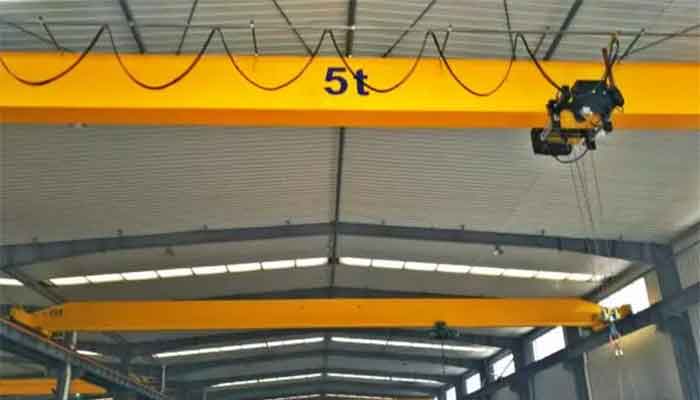
European style explosion proof single girder crane
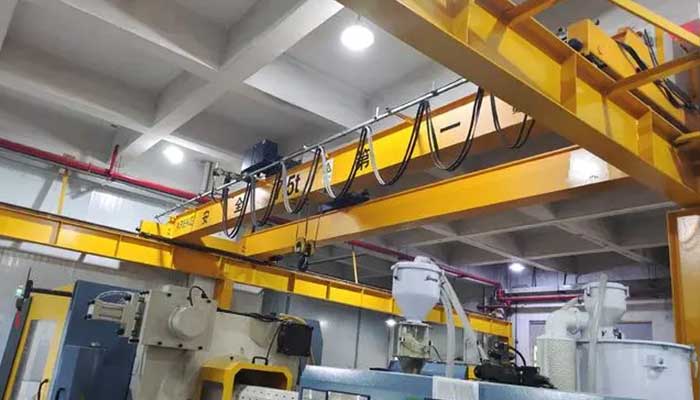
European style explosion proof single girder crane affordable price
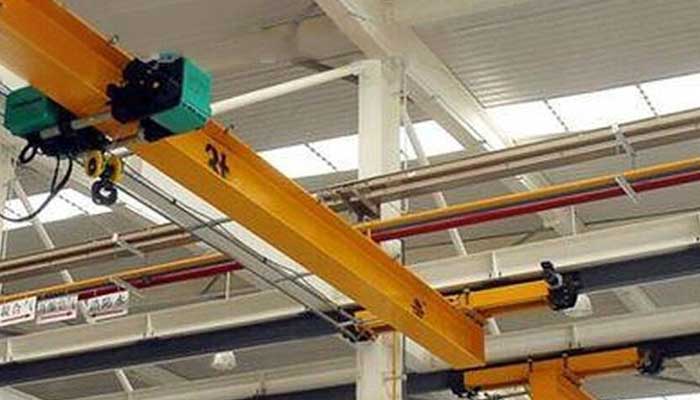
European style explosion proof underhung bridge crane
Industries that Need Explosion-Proof Cranes
Explosion-proof cranes are crucial in industries that deal with materials or environments where explosions can occur. These industries face constant risks from hazardous substances like explosive gases, vapors, or dust. Here are some key sectors where explosion-proof cranes are a must:
- Oil and Gas Industry: Refineries, drilling rigs, offshore platforms, and gas processing plants are full of volatile gases and liquids, which create significant explosion risks. An explosion-proof crane ensures safety during loading, unloading, and other operations in these high-risk areas.
- Chemical Manufacturing: Many chemicals used in production, such as solvents and acids, are highly flammable. These facilities often work with dangerous substances that could ignite, requiring cranes that meet explosion-proof standards to protect both equipment and personnel.
- Mining Industry: In coal mines or mines dealing with explosive dust and gases, explosion-proof cranes are needed to ensure safe handling of materials. Coal dust, for example, is highly flammable and can easily lead to explosions if not properly managed.
- Pharmaceutical Industry: Some pharmaceutical plants handle volatile powders and chemicals that are sensitive to heat, sparks, or electrical faults. Explosion-proof cranes are necessary to safely handle materials during the manufacturing process.
- Food Processing: In certain food production facilities, dust from grain or sugar can create explosive atmospheres. Explosion-proof cranes are required to manage the handling of such materials without the risk of ignition.
In each of these industries, explosion-proof cranes not only ensure operational safety but also help meet regulatory requirements for hazardous environments.
Types of Hazardous Environments
Explosion-proof cranes are designed to operate safely in specific hazardous environments, which are classified based on the likelihood of an explosion occurring. These classifications are important because they determine the level of safety required in the equipment. Here's a closer look at the different types of hazardous zones:
- Zone 0: The most hazardous area, where explosive gases, vapors, or liquids are present all the time or for long periods. It is typically found in the interior of storage tanks or process vessels in refineries and chemical plants.
- Zone 1: Explosive gases or vapors are likely to occur during normal operations. This zone is common in areas like reactor rooms, pipelines, or areas near chemical storage tanks.
- Zone 2: Explosive gases or vapors are unlikely to occur during normal operation, but may be present for a short time during abnormal conditions (such as a leak). This could be found in ventilation areas, or in the vicinity of equipment that might leak occasionally.
- Explosive Dust Atmospheres: These environments, like coal mining operations or grain silos, contain combustible dust that can create a fire or explosion hazard. Dust accumulation is a major concern, and explosion-proof cranes are crucial to ensure that any handling of dust or powders doesn't trigger a dangerous situation.
Each of these zones requires different levels of protection. For example, a crane used in Zone 0 will need the highest level of protection, with all components fully sealed and certified for continuous exposure to explosive gases. On the other hand, cranes used in Zone 2 can often be designed with slightly lower levels of protection, as the risks are less frequent.
Sign 1: Frequent Handling of Flammable Materials
Environments with High Flammability Risks
Some work environments are inherently dangerous due to the presence of flammable materials, such as gases, vapors, liquids, or dust. These materials can easily ignite from a spark, heat, or friction if not properly managed. Flammable substances often create explosive atmospheres, where even a small ignition source can trigger catastrophic accidents.
Common environments with high flammability risks include:
- Chemical plants: These facilities often deal with volatile chemicals like solvents, acids, and alcohols that can vaporize and mix with the air, creating explosive conditions.
- Petrochemical refineries: Refineries process fuels and gases, including gasoline, diesel, natural gas, and other highly flammable liquids and gases. The risk of explosions is high due to frequent handling of these materials.
- Mining operations: Particularly in coal mines, where coal dust is highly combustible and can cause devastating explosions if not carefully controlled.
- Grain storage facilities: Grain dust can easily ignite, creating dangerous conditions in processing and storage areas.
- Pharmaceutical manufacturing: In pharmaceutical plants, volatile chemicals and powders used in drug production can easily catch fire, making safety measures critical.
In all these environments, the handling of flammable materials requires special attention to prevent accidents. This is where explosion-proof cranes play a crucial role.
Examples of Industries Handling Flammable Materials
Certain industries are more likely to encounter hazardous materials on a daily basis. These industries require explosion-proof cranes to safely operate in flammable environments. Here are some examples:
- Petrochemical and Oil Refineries: These facilities process and handle fuels and chemicals, such as crude oil, natural gas, ethylene, and benzene, which can easily ignite when exposed to sparks, heat, or friction. Workers in these industries rely on explosion-proof cranes to safely manage hazardous materials, ensuring both their safety and regulatory compliance.
- Coal Mining: Coal dust is highly explosive and can cause deadly dust explosions. Coal mines often use overhead cranes to handle equipment, materials, and coal itself. In these environments, explosion-proof cranes are essential to prevent dangerous ignition from mechanical failure or external sources.
- Chemical Manufacturing: The chemical industry is another prime example, where highly flammable gases or chemicals like acetylene, ethanol, and propane are routinely handled. These substances pose a significant risk of fire and explosion. Explosion-proof cranes ensure safe material handling in these highly volatile environments.
- Food Processing Plants: In food production facilities, especially those handling dry goods like flour or grain, dust can accumulate and create an explosive atmosphere. Explosion-proof cranes are necessary to minimize the risks associated with dust explosions.
- Pharmaceutical Plants: Some drugs and chemicals used in pharmaceutical manufacturing are highly flammable, and these plants are equipped with explosion-proof cranes to ensure that volatile substances are moved safely without triggering fires or explosions.
Risks of Using Standard Cranes in Flammable Environments
Using standard cranes in environments where flammable materials are present is a dangerous practice. Regular cranes are not designed to prevent ignition, and they can pose significant risks in hazardous zones. Here are the key risks:
- Sparks and Heat Generation: Standard cranes, especially older models or poorly maintained ones, can generate sparks or heat during operation. In environments with flammable gases, liquids, or dust, these sparks can easily lead to an explosion.
- Electrical Failures: Non-explosion-proof cranes can experience electrical malfunctions that might cause sparks, arcing, or overheating. In hazardous environments, even a small electrical failure can lead to catastrophic consequences, such as fires or explosions.
- Mechanical Failures: Crane components like brakes, motors, or gears can fail under heavy use. If a failure happens in an environment with explosive materials, it may trigger an accident. Regular cranes are not built to prevent or contain the dangers associated with mechanical issues in these environments.
- Regulatory Non-compliance: Many industries operating with hazardous materials are required by law to use explosion-proof equipment. Failure to comply with regulations can result in legal penalties, business shutdowns, or liability in the event of an accident.
In these high-risk environments, using standard cranes can lead to safety breaches, expensive accidents, legal consequences, and even loss of life.
Benefits of Investing in an Explosion-Proof Crane
Investing in an explosion-proof crane is a smart decision for industries dealing with flammable materials. Here are the key benefits:
- Enhanced Safety: Explosion-proof cranes are specifically designed to prevent sparks, heat, and electrical malfunctions that could ignite hazardous materials. This reduces the risk of accidents, fires, or explosions, ensuring a safer workplace for your employees.
- Compliance with Safety Regulations: Explosion-proof cranes are built to meet strict safety standards and regulations like ATEX and IECEx. These certifications ensure that your facility stays compliant with legal requirements for hazardous environments, reducing the risk of fines and shutdowns.
- Reduced Risk of Damage and Downtime: With explosion-proof cranes, the risk of mechanical failure or electrical issues triggering an explosion is minimized. This helps avoid costly downtime, repairs, and equipment damage, keeping your operations running smoothly.
- Improved Insurance and Liability Protection: Insurance providers often require facilities in hazardous environments to use explosion-proof equipment. By investing in these cranes, you not only ensure safety but also protect your business from liability claims in case of accidents.
- Long-Term Cost Savings: While explosion-proof cranes might have a higher initial cost, their durability, reliability, and safety features make them a wise investment in the long run. They help avoid the costs associated with accidents, legal fees, insurance hikes, and regulatory fines.
In short, explosion-proof cranes are designed to protect both people and assets in industries that handle dangerous, flammable materials. By investing in one, you're reducing risks, ensuring compliance, and creating a safer work environment.
Sign 2: Operating in Hazardous Zones
Understanding Hazardous Zones
Hazardous zones are classified based on the likelihood of explosive gases or dust being present in the air. These zones are used to determine what level of protection is needed for equipment like overhead cranes. The zones are defined as follows:
- Zone 0: This is the most hazardous zone, where explosive gases, vapors, or liquids are present continuously or for long periods of time. It typically exists in the interior of storage tanks, reactors, or other sealed containers. In this zone, any equipment used must be specially designed to prevent any possible ignition sources.
- Zone 1: In this zone, explosive gases or vapors are likely to occur during normal operations. These areas may include areas near equipment that often release flammable substances, such as chemical processing units or pump rooms. The equipment used here must be robust enough to handle these conditions.
- Zone 2: This zone is less dangerous, where explosive gases or vapors are unlikely to occur under normal conditions but may be present during abnormal conditions, like equipment malfunction or leaks. It can be found in places like ventilation systems or areas where minor releases of hazardous gases may occasionally happen.
- Explosive Dust Atmospheres: These areas contain dust that can ignite when dispersed in the air. Industries like coal mining, grain milling, or metal processing facilities fall into this category. The dust creates a risk of combustion if an ignition source, such as a spark or excessive heat, is present.
Each zone presents different risks, and the classification helps determine the type of equipment and safety features needed.
What Makes a Zone Hazardous for Overhead Crane Operations?
Certain factors make hazardous zones particularly dangerous for overhead crane operations:
- Presence of Flammable or Explosive Gases: In areas where gases like propane, methane, or acetylene are common, even a small spark from a crane's motor, controls, or electrical wiring can ignite these gases and cause an explosion.
- Explosive Dust: In environments with dust like coal, flour, or metal particles, the fine particles suspended in the air create a highly explosive atmosphere. When mixed with air, even the slightest spark from a crane can set off a dust explosion.
- Frequent Exposure to Hazardous Materials: Zones where flammable chemicals are handled regularly can be risky, as these materials are more likely to create hazardous atmospheres. For example, chemical plants or oil refineries where volatile substances are often in use require extreme caution to prevent ignition.
- Temperature Extremes or Mechanical Stress: Areas that deal with extreme temperatures or heavy mechanical stress, like those found in refineries or industrial furnaces, create conditions that make equipment more prone to failure, leading to potential ignition hazards.
In these conditions, using regular cranes is a huge risk because they are not built to handle the explosive potential of the environment. Standard cranes could malfunction, generate heat, or produce sparks, all of which are dangerous in hazardous zones.
How Explosion-Proof Cranes Meet the Specific Standards for Hazardous Zone Classification
Explosion-proof cranes are designed to meet the specific standards for each hazardous zone, ensuring safe operation in environments where the risk of explosion is high. These cranes are built to the required specifications for each zone's particular needs:
- For Zone 0: Explosion-proof cranes used in Zone 0 are built to withstand continuous exposure to explosive gases or vapors. These cranes have fully sealed electrical and mechanical components to prevent any possibility of sparks or heat escaping. Additionally, they must be rated for continuous operation in explosive atmospheres.
- For Zone 1: Cranes used in Zone 1 environments are designed to safely operate when explosive gases or vapors are likely to occur during normal operations. They have protective enclosures, reinforced seals, and safety features that can withstand occasional exposure to hazardous materials.
- For Zone 2: In Zone 2, where explosive gases or vapors are unlikely under normal conditions, but may occur in abnormal circumstances, explosion-proof cranes are designed with features that can handle brief exposure to hazardous gases. These cranes have safe, reliable control systems and explosion-proof electrical systems to prevent ignition in case of leaks or other irregularities.
- For Dust Hazard Areas: Cranes in environments with explosive dust are designed to prevent any sparks or overheating that could trigger a dust explosion. The equipment is sealed to keep dust from entering sensitive parts, and the crane's motors and controls are designed to limit heat generation and prevent static discharge.
Explosion-proof cranes meet these zone-specific standards to ensure the safety of workers and the equipment itself.
Regulatory Compliance and Safety Standards
The operation of cranes in hazardous zones is strictly regulated to prevent accidents. These regulations ensure that the right equipment is used in the right environments. Some key standards and compliance measures include:
- ATEX Certification (EU): In the European Union, equipment used in hazardous environments must comply with the ATEX directive, which outlines requirements for equipment used in explosive atmospheres. This certification ensures that the crane meets safety standards for the zone it will be used in.
- IECEx Certification (International): The International Electrotechnical Commission (IEC) sets standards for explosion-proof equipment that are recognized worldwide. The IECEx certification ensures that equipment is safe for use in hazardous zones, whether in mining, oil, or chemical plants.
- OSHA Standards (USA): In the United States, the Occupational Safety and Health Administration (OSHA) enforces safety regulations for cranes used in hazardous environments. These regulations require equipment to be inspected and certified for safe operation in explosive atmospheres.
- NFPA 70 (National Fire Protection Association): In the U.S., NFPA 70 provides guidelines for electrical safety in industrial settings, including the use of explosion-proof equipment. The standards ensure that electrical systems in cranes are safe for operation in hazardous zones.
By following these regulations and standards, explosion-proof cranes are built to operate safely, reduce the risk of accidents, and comply with local and international safety laws. Using certified explosion-proof cranes ensures that your facility is in compliance and that your workers are protected from hazardous conditions.
Sign 3: Increased Safety and Regulatory Requirements
Overview of Safety Regulations and Codes
In industries dealing with hazardous environments, strict safety regulations are in place to protect workers, facilities, and the surrounding community from the risks of explosions, fires, and other accidents. These regulations and codes outline specific standards for equipment, including cranes, to ensure safe operations in environments where flammable gases, vapors, or dust are present.
Some key safety regulations and codes include:
- ATEX (Atmosphères Explosibles): ATEX is a set of regulations from the European Union that outlines the requirements for equipment used in explosive atmospheres. It categorizes hazardous environments into Zones 0, 1, 2 (for gases), and Zone 20, 21, 22 (for dust), and specifies the safety standards for equipment used in those zones. Explosion-proof cranes must be ATEX certified to operate safely in these areas.
- IECEx (International Electrotechnical Commission Explosive Atmosphere): IECEx is an international certification system that provides a global standard for equipment used in explosive environments. It ensures that equipment, including cranes, is safe to use in hazardous areas. The IECEx certification is recognized worldwide, helping companies comply with local regulations across different countries.
- OSHA (Occupational Safety and Health Administration): In the United States, OSHA sets forth safety regulations, including guidelines for equipment used in hazardous environments. OSHA regulations often require explosion-proof equipment to be used in environments where explosive gases or dust are present, such as chemical plants, oil refineries, or mining operations.
- NFPA 70 (National Fire Protection Association): NFPA 70 is the National Electrical Code (NEC) in the United States, which specifies standards for electrical installations and equipment in hazardous areas. It includes guidelines for explosion-proof wiring, electrical enclosures, and equipment like overhead cranes in explosive atmospheres.
These regulations ensure that businesses are taking the necessary precautions to minimize the risk of accidents, comply with local and international safety standards, and protect employees from harm.
Importance of Meeting Regulatory Requirements in Certain Industries
Meeting safety regulations is not just about protecting equipment—it's about safeguarding people and ensuring compliance with the law. Many industries, such as oil and gas, chemicals, mining, and pharmaceuticals, operate in hazardous environments where flammable gases or dust are common. These industries are required to adhere to strict safety standards to prevent accidents like explosions, fires, or chemical leaks.
By following these regulations:
- Workers Are Protected: Safety standards ensure that employees are working in an environment that minimizes exposure to dangerous conditions. Explosion-proof cranes provide the necessary protection from ignition risks in areas where flammable materials are present.
- Companies Stay Compliant: Regulatory bodies require businesses to follow specific codes and standards to avoid hefty fines, operational shutdowns, or legal actions. Companies that fail to meet regulatory requirements may face severe financial consequences or legal liability in case of an accident.
- Environmental Protection: Accidents in hazardous environments can have serious environmental consequences. Explosions, fires, or chemical spills can contaminate the air, water, and soil, affecting not only workers but also surrounding communities. Compliance with safety standards ensures that environmental risks are minimized.
The Role of Explosion-Proof Cranes in Ensuring Compliance with Safety Standards
Explosion-proof cranes play a crucial role in ensuring that companies comply with safety regulations and industry codes. These cranes are designed and built with features that meet the standards set by regulations like ATEX, IECEx, and OSHA. Key roles they play in compliance include:
- Preventing Ignition Sources: Explosion-proof cranes are specifically designed to prevent any sparks, heat, or friction that could ignite flammable gases or dust. Their motors, electrical components, and mechanical systems are sealed or housed in explosion-proof enclosures to prevent ignition, which helps companies comply with regulations that require ignition protection.
- Certifying Equipment for Hazardous Zones: Explosion-proof cranes come with certifications that prove they are safe for use in hazardous environments. These certifications, such as ATEX or IECEx, are necessary for operations in industries like oil and gas, chemical manufacturing, and mining. By using certified equipment, companies demonstrate their commitment to meeting safety standards and reducing workplace hazards.
- Meeting Local and International Requirements: Depending on the region and industry, companies may be required to follow different regulations. Explosion-proof cranes are built to meet both local and international standards, ensuring that businesses can operate safely and legally in various jurisdictions.
By using explosion-proof cranes, companies not only ensure the safety of their workers but also protect their business from the risks associated with non-compliance. These cranes serve as an essential piece of equipment for any business working in hazardous environments.
Consequences of Non-Compliance and Risks Involved
Failing to comply with safety regulations can have serious consequences for businesses. These include:
- Legal Penalties: Regulatory bodies like OSHA or local authorities can impose heavy fines on companies that fail to meet safety standards. In severe cases, non-compliance may result in the suspension or closure of operations until the necessary corrective actions are taken.
- Workplace Accidents: Non-compliance with safety standards increases the risk of accidents like explosions, fires, or chemical spills. These accidents can result in worker injuries, fatalities, and significant damage to the facility. The human and financial costs of such accidents are often far greater than the cost of investing in proper equipment, such as explosion-proof cranes.
- Insurance Issues: Failure to meet safety standards can result in higher insurance premiums or even a complete loss of coverage. In the event of an accident, insurers may refuse to cover damages if the company failed to comply with regulatory requirements.
- Reputation Damage: Companies that are found to be non-compliant with safety regulations risk damaging their reputation. Negative publicity, lawsuits, or accidents can harm relationships with clients, investors, and the public. The long-term damage to a company's brand can have financial implications far beyond the immediate costs of non-compliance.
In conclusion, complying with safety and regulatory requirements is not optional—it's critical for ensuring safe operations, protecting workers, and avoiding significant legal and financial risks. Explosion-proof cranes are a key investment for companies operating in hazardous zones, as they help ensure compliance with industry codes, keep workers safe, and protect the business from potential disaster.
Sign 4: Recurrent Crane Failures or Safety Concerns
Identifying the Signs of Wear and Tear in Standard Cranes Operating in Hazardous Environments
When overhead cranes are used in hazardous environments, they face more wear and tear than cranes operating in safer conditions. This is due to the constant exposure to dangerous materials, temperature extremes, and the increased risk of mechanical strain. Over time, these factors can lead to the degradation of crane components, resulting in safety hazards and operational disruptions. Here are some signs that indicate wear and tear in standard cranes:
- Increased Maintenance Needs: If your crane is constantly requiring repairs or maintenance, it's a clear sign that the equipment is deteriorating. Frequent issues such as motor overheating, irregular lifting movements, or issues with the hoisting mechanism can indicate that the crane isn't functioning properly.
- Unusual Noises: Odd noises like grinding, squeaking, or rattling sounds from the crane's mechanical components are usually signs of wear. These noises can be caused by worn-out parts, such as bearings, gears, or drive motors.
- Frequent Breakdown of Electrical Components: In hazardous environments, electrical components are particularly susceptible to damage due to the high presence of gases, dust, or moisture. If electrical systems like switches, control panels, or wiring frequently malfunction, it could indicate that the crane is not suitable for the environment.
- Visible Cracks or Corrosion: Physical damage, like cracks in the crane's frame or corrosion due to exposure to chemicals or moisture, is another warning sign. This damage can compromise the crane's integrity, leading to potential structural failure.
- Poor Performance or Reduced Load Capacity: If the crane's load capacity begins to decrease or the lifting performance becomes erratic, it suggests that the components are losing efficiency or their structural integrity. In hazardous environments, this could lead to dangerous accidents or failures.
These signs indicate that the crane is reaching the end of its operational lifespan, and continuing to use it in hazardous conditions could put your workers, equipment, and facility at risk.
How an Explosion-Proof Crane Can Reduce the Risk of Failures and Enhance Safety
Explosion-proof cranes are specifically designed to handle the challenges of hazardous environments. By incorporating advanced safety features and durable components, they significantly reduce the risk of failures and enhance overall safety. Here's how they help:
- Sealed Components: Explosion-proof cranes are built with sealed electrical systems and mechanical components that prevent sparks, heat, or debris from escaping. This ensures that even in the most volatile environments, the risk of an ignition is minimized, reducing the chances of fires or explosions.
- Enhanced Durability: These cranes are designed to withstand harsh conditions, such as high temperatures, exposure to corrosive chemicals, and heavy dust or gas concentrations. Their robust construction helps prevent the wear and tear commonly seen in standard cranes.
- Regular Maintenance Alerts: Many explosion-proof cranes are equipped with diagnostic systems that alert operators and maintenance teams to potential issues before they become serious problems. This allows for timely maintenance, preventing failures before they happen.
- Redundant Safety Systems: Explosion-proof cranes often have built-in redundant safety systems, such as backup power supplies and fail-safe mechanisms. If a critical component fails, these backup systems take over, reducing the risk of accidents and downtime.
- Compliance with Industry Standards: By meeting stringent safety standards (like ATEX and IECEx certifications), explosion-proof cranes ensure that they are capable of handling the risks of hazardous environments, reducing the potential for failure caused by unsafe equipment.
In hazardous environments, the increased risk of crane failure makes explosion-proof cranes a critical investment for maintaining safety and operational continuity.
Case Studies or Examples Where Crane Failure Led to Accidents or Damage
The consequences of crane failure in hazardous environments can be severe. Here are a couple of examples that highlight the risks involved:
- Case Study 1: Chemical Plant Explosion
In a chemical plant, an overhead crane was used to handle flammable liquids. Over time, the crane's electrical system began to show signs of wear, including frequent short circuits and overheating. Despite repeated maintenance, the crane's wiring failed during a routine operation, creating sparks that ignited nearby flammable vapors. This led to a catastrophic explosion that caused significant damage to the plant, injured several workers, and resulted in costly legal claims and fines. An explosion-proof crane, specifically designed to handle these hazardous conditions, could have prevented this disaster by offering more reliable electrical insulation and explosion-proof components. - Case Study 2: Mining Operation Fire
In a coal mining operation, a standard crane was used to transport materials through a dusty environment. The crane was not designed to handle the flammable dust and experienced repeated motor failures. Eventually, a spark from the motor ignited the coal dust in the air, leading to a massive fire. The fire destroyed critical equipment, delayed operations, and caused extensive damage. If an explosion-proof crane had been in use, it would have been designed to prevent sparks and eliminate heat generation, reducing the risk of ignition in the dust-filled environment.
These examples demonstrate how recurrent crane failures can lead to disastrous consequences in hazardous environments. Investing in an explosion-proof crane could have prevented these accidents, protecting both employees and equipment while ensuring operational continuity.
In summary, regular wear and tear in cranes operating in hazardous environments can lead to serious safety concerns. By investing in explosion-proof cranes, you can significantly reduce the risk of failures, ensure compliance with safety regulations, and avoid accidents that could cause severe damage to your facility and harm to workers.
Sign 5: Plans for Expansion into More Hazardous Areas
How Business Growth or Expansion into More Hazardous Environments Can Trigger the Need for Explosion-Proof Cranes
As businesses grow, they often expand into new operational areas that may have higher levels of risk due to increased exposure to hazardous substances. Whether it's moving to a larger facility, developing new production lines, or entering a different sector, the expansion can bring new challenges related to safety. If your business is expanding into environments where flammable gases, vapors, or dust are more prevalent, then investing in explosion-proof cranes becomes a necessity.
Here's why:
- New Hazardous Zones: When expanding, companies may find themselves operating in environments classified as more hazardous (such as Zone 0 or Zone 1 for gas or Zone 20 for dust). These zones require specialized equipment designed to handle the increased risk of ignition.
- Increased Material Handling: As production or processing scales up, the handling of flammable or volatile materials may increase. For example, in the chemical or oil industries, as companies expand their operations, they may need to lift larger quantities of hazardous materials. This raises the risk of sparks or other ignition sources, making explosion-proof cranes essential to maintaining safety.
- New Regulatory Requirements: Expanding operations often means that businesses have to comply with stricter regulations, particularly if they are now operating in more dangerous areas. Explosion-proof cranes meet these higher standards, ensuring that your equipment stays compliant with updated codes, such as ATEX, IECEx, or OSHA.
Cost-Benefit Analysis: Preparing for Future Needs and Regulatory Changes
When businesses are planning for expansion, it's essential to consider the long-term costs and benefits of upgrading equipment to meet new safety standards. Although explosion-proof cranes might require a higher initial investment compared to standard cranes, the long-term benefits often outweigh the upfront cost, particularly in the context of expansion into more hazardous areas.
Here's a breakdown of the cost-benefit considerations:
- Avoiding Potential Downtime: Explosions, fires, and other accidents can cause significant operational downtime. This can be incredibly costly, especially in industries like oil and gas, mining, or chemical production, where time is money. Explosion-proof cranes, while more expensive upfront, reduce the risk of catastrophic failures, which could otherwise lead to expensive shutdowns or repair costs.
- Regulatory Compliance: As mentioned earlier, industries that deal with hazardous materials face strict safety regulations. Non-compliance can result in hefty fines, legal costs, and even facility shutdowns. Upgrading to explosion-proof cranes ensures that your company remains in compliance with the latest safety standards, reducing the risk of regulatory penalties.
- Long-Term Savings: Explosion-proof cranes are designed for durability in hazardous environments. While they may be more expensive initially, their longevity and reliability mean fewer repairs and replacements. They are built to withstand the wear and tear of working in dangerous conditions, which can lead to significant savings over time in maintenance costs.
- Improved Worker Safety: Investing in the right equipment is ultimately about protecting your workforce. Explosion-proof cranes are specifically designed to prevent accidents that could lead to worker injuries or fatalities. The cost of implementing these safety measures is far less than the cost of dealing with an incident that could have been prevented with the proper equipment.
- Enhanced Insurance Coverage: Many insurance companies offer better rates or coverage options to businesses that prioritize safety measures, including using explosion-proof cranes. This can help offset the higher initial cost of the equipment by reducing insurance premiums.
Case Study or Scenario Illustrating the Transition to Higher-Risk Areas and the Need for Upgraded Equipment
Let's consider a scenario where a company in the oil and gas industry is expanding its operations to a new drilling site. This site is located in a highly volatile area with increased concentrations of natural gas and other combustible materials. As a result, the site falls under Zone 0 for gases, which is considered an area with the highest level of risk for explosions.
Initially, the company was using standard cranes for material handling at its existing, less hazardous site. However, with the new expansion into a higher-risk area, the company realized that their current cranes wouldn't meet the necessary safety requirements. They faced the following challenges:
- Increased Risk: The new site had a higher concentration of explosive gases, and the existing cranes were not designed to prevent sparks or overheating in such conditions.
- Regulatory Pressure: The new site's location and classification meant that stricter safety regulations applied. The company would be required to meet ATEX and IECEx standards for all equipment used in the area. Their current cranes could not comply with these regulations.
- Higher Insurance Premiums: The company's insurance provider informed them that they would need to upgrade their cranes to explosion-proof models to continue coverage. Without upgrading, their premiums would increase significantly, and they might even lose coverage altogether in the event of an accident.
Faced with these challenges, the company made the decision to invest in explosion-proof cranes. The benefits of this decision included:
- Safety and Compliance: By switching to explosion-proof cranes, the company ensured the safety of its workers and met all regulatory requirements.
- Reduced Risk of Downtime: With safer, more reliable equipment, the company minimized the risk of accidents and the costly downtime that would follow any incident.
- Long-Term Financial Benefits: Though the initial investment was higher, the company realized significant long-term savings due to reduced insurance costs, fewer repairs, and the avoidance of legal or regulatory fines.
This scenario clearly illustrates how expansion into more hazardous environments necessitates the need for upgrading to explosion-proof cranes. By investing in equipment designed to handle the increased risks, the company not only protected its workforce but also safeguarded its operations and long-term profitability.
In conclusion, if your business is planning to expand into areas with higher levels of risk, it's crucial to consider upgrading to explosion-proof cranes. These cranes offer enhanced safety, compliance with stringent regulations, and long-term cost savings that ultimately protect both your workers and your bottom line.
Sign 6: Prevention of Explosions and Protecting Personnel
Detailed Discussion on How Explosion-Proof Cranes Prevent Ignition Sources in Explosive Atmospheres
One of the most critical roles of explosion-proof cranes is preventing ignition sources in environments where flammable gases, vapors, dust, or fibers are present. Standard cranes, even with regular maintenance, can unintentionally create sparks, heat, or friction—any of which could lead to catastrophic explosions in hazardous environments. Explosion-proof cranes are specifically engineered to eliminate these risks.
Here's how they work:
- Sealed and Enclosed Electrical Components: Explosion-proof cranes are built with electrical components that are completely sealed and enclosed. This prevents any sparks from escaping into the surrounding atmosphere. For instance, the motors, switches, and wiring are designed with special enclosures that ensure they remain isolated, even if the crane malfunctions.
- Non-Sparking Materials: Explosion-proof cranes are made using materials that are resistant to sparking. For example, their mechanical components, including the gearbox, hoisting mechanism, and lift chains, are often made from materials such as aluminum, stainless steel, or non-sparking alloys. These materials help prevent the generation of sparks during operation.
- Temperature Control: The components of explosion-proof cranes are designed to operate within specific temperature limits to avoid overheating, which can be another ignition source. By using temperature sensors and advanced cooling systems, these cranes ensure that critical components remain within safe operating temperatures, further reducing the risk of sparks or heat-induced fires.
- Explosion-Proof Hoisting Mechanisms: The hoisting mechanism of these cranes, such as the hooks and ropes, is specially designed to avoid friction that could cause heat generation or create sparks. This is crucial when working with volatile materials, where even the smallest spark can be catastrophic.
In short, explosion-proof cranes are designed to proactively prevent the ignition of flammable materials by eliminating common ignition sources such as sparks, heat, or electrical faults.
Safety Benefits for Operators, Maintenance Personnel, and the Surrounding Environment
Explosion-proof cranes are not only essential for protecting the equipment and the materials being handled, but they also provide significant safety benefits for personnel operating the cranes and working in the vicinity. Here's how:
- Operator Protection: Operators are directly at risk when handling materials in hazardous environments. Explosion-proof cranes are designed with safety features like remote control systems, explosion-proof cabs, and fail-safe mechanisms to ensure that operators can safely control the crane from a secure location. This reduces their exposure to the dangers of sparks, toxic fumes, or potential explosions.
- Maintenance Safety: Maintenance personnel who are tasked with inspecting and repairing cranes are often exposed to the same hazards as operators. Explosion-proof cranes provide additional layers of protection during maintenance operations. For example, the cranes are equipped with easily accessible, sealed components that reduce the risk of accidental exposure to hazardous gases or chemicals during inspections or repairs.
- Environmental Protection: The safe operation of explosion-proof cranes also extends to the surrounding environment. These cranes prevent the release of harmful substances and minimize the risk of ignition in explosive atmospheres. This not only protects workers but also prevents environmental damage that could result from an uncontrolled fire or explosion.
By reducing the potential for ignition, explosion-proof cranes protect not only the direct users but also the larger environment in which they operate.
Impact on Overall Workforce Safety and Legal Protection for the Company
The implementation of explosion-proof cranes has a profound impact on overall workforce safety. By investing in these specialized cranes, businesses show a commitment to prioritizing safety, which can have long-term benefits for both the workforce and the company as a whole.
- Increased Worker Confidence: When workers know that their employer is using the safest equipment available, it boosts their confidence in the workplace. They feel protected, which can increase productivity and morale. The peace of mind that comes from knowing that their safety is being actively safeguarded can reduce stress and improve job satisfaction.
- Reduced Risk of Workplace Accidents: Explosion-proof cranes help mitigate the risks of explosions, fires, and other hazards that are common in industries dealing with flammable or hazardous materials. By eliminating these risks, businesses significantly reduce the chances of accidents that could lead to injury or death.
- Legal Protection for the Company: Adopting explosion-proof cranes can help companies maintain compliance with safety regulations and prevent costly legal issues. In industries such as oil and gas, chemicals, and mining, businesses are required to meet strict safety standards set by regulatory bodies like ATEX, IECEx, and OSHA. Failure to comply can lead to hefty fines, lawsuits, and even shutdowns.
Moreover, having explosion-proof cranes in place can protect the company in the event of an accident. If an explosion or fire occurs and it's found that non-explosion-proof equipment was used in a hazardous environment, the company could be held liable for negligence. Investing in explosion-proof cranes provides a strong defense against potential legal claims by demonstrating the company's proactive approach to safety and regulatory compliance.
- Improved Reputation: Companies that invest in the highest safety standards, including explosion-proof cranes, often gain a reputation for being responsible employers and reliable business partners. This can improve relationships with clients, investors, and regulatory authorities, leading to more business opportunities and smoother operations.
Explosion-proof cranes play a crucial role in preventing ignition sources in hazardous environments, protecting both workers and the surrounding environment. The safety benefits they provide extend beyond the operators to include maintenance personnel, the facility, and the broader community. Furthermore, by ensuring compliance with safety regulations, these cranes help companies avoid costly legal issues and safeguard their reputation. Ultimately, investing in explosion-proof cranes not only protects personnel but also strengthens the overall safety culture within the organization, reducing risks and enhancing operational reliability.
Factors to Consider Before Investment
Before investing in an explosion-proof crane, there are several key factors that need to be carefully evaluated to ensure that you are making the right decision for your business's safety, efficiency, and regulatory compliance. Here are the important considerations:
Technical Specifications and Certifications Required for Explosion-Proof Cranes
Explosion-proof cranes are not one-size-fits-all. They come with specific technical requirements based on the hazards in the operating environment. To ensure that the crane meets safety standards and regulatory guidelines, you'll need to pay attention to the following:
- Hazardous Zone Classification: Explosion-proof cranes are designed for use in specific hazardous zones (Zone 0, Zone 1, or Zone 2 for gas, and Zone 20, Zone 21, or Zone 22 for dust). It's important to select a crane that is certified for the zone your operation falls under. The higher the zone classification, the more robust the explosion-proof design needs to be.
- ATEX and IECEx Certifications: These are the most widely recognized safety standards for explosion-proof equipment in Europe and internationally. ATEX (for Europe) and IECEx (for global compliance) certifications ensure that the crane has been tested and meets all safety standards for use in explosive atmospheres. You should verify that the crane you're considering holds these certifications to avoid potential regulatory issues.
- IP Rating: Explosion-proof cranes should also meet the right IP (Ingress Protection) rating, which indicates how well the equipment is protected from dust and water. For environments with explosive dust or liquids, a higher IP rating is necessary to ensure that the crane remains safe to operate.
- Temperature Class: In hazardous environments, temperature control is critical. Explosion-proof cranes are classified into temperature classes based on the maximum surface temperature that the crane can reach. This is important to ensure that the crane doesn't generate enough heat to cause an explosion. Ensure that the crane is suited for the temperature class of your environment.
Cost Considerations: Upfront Investment vs. Long-Term Safety and Efficiency
The cost of explosion-proof cranes is generally higher than standard cranes due to the specialized features and certifications required. However, it's important to evaluate the cost not only in terms of upfront investment but also in the long-term safety and efficiency benefits:
- Upfront Costs: Explosion-proof cranes tend to come with higher purchase costs due to the specialized components and certifications required for operation in hazardous environments. These costs include the materials used to construct the crane, as well as the development and testing required to ensure it meets safety standards.
- Long-Term Savings: While the initial investment is higher, the long-term benefits often outweigh the costs. Explosion-proof cranes are designed to reduce the risk of accidents, which could result in costly downtime, repairs, and insurance claims. They also help businesses avoid regulatory fines for non-compliance. In addition, they reduce the likelihood of catastrophic incidents that could result in significant financial and reputational damage.
- Insurance Benefits: Many insurance companies offer lower premiums to businesses using certified explosion-proof cranes, recognizing the reduced risk of accidents in hazardous environments. These savings can help offset the higher initial costs.
- Maintenance Costs: Explosion-proof cranes are built to last longer and require less frequent maintenance due to their rugged design. Although routine maintenance is still necessary, these cranes are generally more durable, leading to lower long-term maintenance costs.
Assessing Your Existing Crane Fleet and Whether Upgrades Are Necessary
If your business already has an existing crane fleet, it's important to assess whether an upgrade to explosion-proof cranes is necessary. Consider the following factors:
- Current Equipment Performance: Evaluate how well your existing cranes are performing in hazardous environments. If you are frequently experiencing malfunctions, wear and tear, or safety concerns, it may be time to upgrade to more reliable explosion-proof equipment.
- Safety Concerns: If your current cranes are not certified for use in hazardous zones or fail to meet the required safety standards, they pose a significant risk to your workers and operations. In such cases, upgrading to explosion-proof cranes is essential to meet safety regulations and ensure protection.
- Regulatory Compliance: Over time, regulations may change, or your operations may expand into more hazardous environments. If your current cranes are not up to the new standards, an upgrade is necessary to maintain compliance and avoid legal issues.
- Long-Term Planning: Consider your business's long-term needs. If you expect growth or expansion into more hazardous areas, upgrading your fleet to explosion-proof cranes now may prevent future disruptions and additional investment.
Consultation with Safety Experts and Equipment Suppliers
Before making an investment in explosion-proof cranes, it's wise to consult with safety experts and equipment suppliers who can provide valuable insight into your specific needs and help you make an informed decision.
- Safety Experts: Consulting with safety professionals who are familiar with your industry and regulatory requirements can help you determine the exact level of protection needed. They can provide guidance on the best equipment for your environment and help you assess the risks associated with your current setup.
- Equipment Suppliers: Work closely with equipment suppliers who specialize in explosion-proof cranes. They can help you navigate the different models and specifications available, ensuring that you choose the crane that best suits your needs. Suppliers can also assist with installation, certification, and ongoing maintenance.
- Customized Solutions: Many suppliers offer customizable solutions based on your facility's unique needs. For example, if your plant has specific operational requirements or is expanding into new areas, they may be able to recommend equipment that is tailored to those needs.
Investing in explosion-proof cranes is a major decision that requires careful consideration of various technical, financial, and operational factors. By understanding the certifications and specifications required for your environment, weighing the costs and long-term benefits, evaluating your current crane fleet, and consulting with safety experts, you can make a well-informed decision that ensures the safety of your workers and the efficiency of your operations.
Conclusion
Signs and Why Timely Investment is Crucial
We've explored several key signs that indicate the need for an explosion-proof crane, such as:
- Handling Flammable Materials
- Operating in Hazardous Zones
- Increased Safety and Regulatory Requirements
- Recurrent Crane Failures or Safety Concerns
- Plans for Expansion into More Hazardous Areas
- Prevention of Explosions and Protecting Personnel
Each of these factors signals that your current equipment may not be sufficient to ensure the safety, compliance, and efficiency of your operations. Investing in an explosion-proof crane at the right time is crucial to avoid potential accidents, costly downtime, and regulatory violations.
Explosion-proof cranes are designed to eliminate ignition risks, comply with stringent safety standards, and protect workers. Without them, you risk legal consequences and damage to your reputation. Timely investment ensures your facility runs smoothly and safely.
Evaluate Your Current Operations
Take a moment to evaluate your operations:
- Are you handling hazardous or flammable materials?
- Is your crane fleet up to current safety standards?
- Do you anticipate expansion into more hazardous areas?
If you're unsure, it's time to assess your risks. The cost of accidents, downtime, or safety violations far outweighs the investment in a proper explosion-proof crane. Waiting too long could result in costly consequences, both for your operations and for your workers.
Reach Out for Expert Advice and Custom Solutions
Making the right choice can be complicated, but you don't have to do it alone. Reach out to experts who specialize in explosion-proof crane solutions. Our team is ready to help you identify the right equipment for your specific needs, ensure compliance, and maximize safety.
Contact us today for expert advice and customized solutions that will protect your workers, your business, and your bottom line. Don't wait for a safety incident to drive your decision—act now to ensure long-term efficiency and compliance.
Related Products
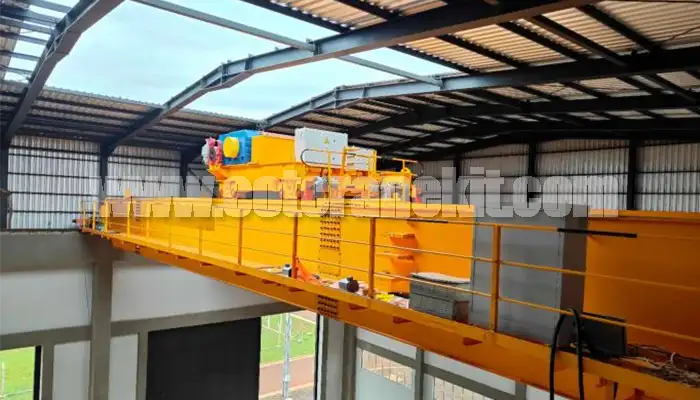
Latest project
150 Ton Overhead Crane Installation Feedback – Paraguay Case
QDX 150 ton overhead crane in action in Paraguay. Installation photos, video, and client feedback show performance, safety, and heavy-lifting efficiency.
Free consultation to Confirm Parameters & Specifications and Get
Latest Crane Price & Crane Rate.
- Types of overhead cranes : _______?
- Optional: Overhead travelling crane, goliath gantry crane,Slewing jib crane, Single girder or double girder crane,small portable crane or kbk crane, etc.
- Capacity of overhead crane: _______?
- Optional: 0.25ton, 0.5 ton, 1 ton, 2 ton, 3ton, 5 ton, 10 ton,15ton, 20ton, 25 ton, 30ton,35ton, up to 550ton, etc.
- Crane span & lifting height : _______?
- Crane travelling length : _____?
- Control of overhead crane:_______?
- Optional: pendant/ remote/cabin control
- Voltage supply of overhead crane:_____?
- Eg,: 380V50/60HZ,3Phase or others,etc.
- Application/usage of crane:_______?
- Eg,: Steel mill, ,injection mold, cement,stone, concrete,granite, general manufacturing, etc.
Just leave a message via the contact form and our hoist and crane engineer will contact you with in 24working hours.
Get In Touch
